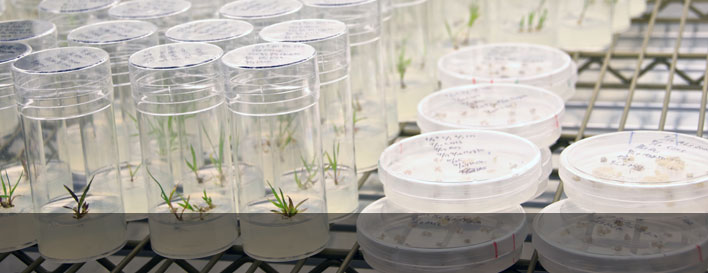Dr. Rolf Jentoft


Cellulosic Bioenergy Research: Chemical Conversion
Sustainable fuel sources, such as biomass derived oils, must undergo multiple processing steps before they can be utilized. Catalysts can accelerate and direct the necessary reaction steps and can have a large impact on the viability of the refining process. Dr. Jentoft's research is in the testing and characterization of catalysts and related materials used in the processing of hydrocarbons and oxygenates.
The most direct characterization of a catalyst is to measure its activity. Combining activity information with knowledge of the active surface can be used to direct improvement of the catalyst, and may lead to a fundamental understanding of how a catalyst works. However, because a catalyst at room temperature and exposed to air does not have the same structure as the same material under reaction conditions (usually increased temperature and reactant atmosphere), it is useful to characterize the catalyst under reaction conditions. X-ray absorption spectroscopy is an element specific spectroscopic technique that gives information on the local environment (within about 5 Ǻ) as well as information on the average valence. Dr. Jentoft and his co-researchers have designed and constructed measurement cells for transmission and fluorescence mode measurements of catalyst under reaction conditions.
The synthesis of catalysts usually requires several thermal treatments such as drying, calcination, and activation. Optimization of these steps can enhance the activity of the catalyst. To efficiently optimize thermal treatment it is useful to understand the kinetics of the transformations occurring during treatment. Kinetic information can be obtained through measurement of changes in weight (Thermo Gravimetric Analysis), gas products analysis, and measurement of heat effects occurring during heating in a controlled atmosphere. Temperature programmed desorption, reduction, or oxidation can also be used to characterize acid/base properties, oxidation state, reactivity and to optimize regeneration parameters for catalysts.
- Jentoft, R. E., A. P. Hahn, F. C. Jentoft, and T. Ressler (2005). "In Situ XANES Study of Mn in Promoted Sulfated Zirconia Catalysts." Physical Chemistry Chemical Physics 7.14: 2830-838. Physical Chemistry Chemical Physics. doi: 10.1039/B505464H.
Access the publication
- Muller, J. O., D. S. Su, R. E. Jentoft, J. Krohnert, F. C. Jentoft, and R. Schlogl (2005). "Morphology-controlled Reactivity of Carbonaceous Materials towards Oxidation." Catalysis Today 102-103: 259-65. SciVerse. doi: 10.1016/j.cattod.2005.02.025.
Access the publication
- Jentoft, F. C., A. Hahn, J. Kröhnert, G. Lorenz, R. E. Jentoft, T. Ressler, U. Wild, R. Schlögl, C. Häßner, and K. Köhler (2004). "Incorporation of Manganese and Iron into the Zirconia Lattice in Promoted Sulfated Zirconia Catalysts." Journal of Catalysis 224.1: 124-37. SciVerse. doi: 10.1016/j.jcat.2004.02.012.
Access the publication
- Purnama, H., T. Ressler, R. E. Jentoft, H. Soerijanto, R. Schlögl, and R. Schomäcker (2004). "CO Formation/selectivity for Steam Reforming of Methanol with a Commercial CuO/ZnO/Al2O3 Catalyst." Applied Catalysis A: General 259.1: 83-94. SciVerse. doi: 10.1016/j.apcata.2003.09.013.
Access the publication
- Yang, X., F. C. Jentoft, R. E. Jentoft, F. Girgsdies, and T. Ressler (2002). "Sulfated Zirconia with Ordered Mesopores as an Active Catalyst for N-Butane Isomerization." Catalysis Letters 81: 25-31. Springer Link. doi: 10.1023/A:1016095603350.
Access the publication
- Hahn, A., T. Ressler, R. E. Jentoft, and F. C. Jentoft (2001). "The Role of the "Glow Phenomenon" in the Preparation of Sulfated Zirconia Catalysts." Chemical Communications: 537-38. RSC Publishing. doi: 10.1039/B100364J.
Access the publication
- Jentoft, R. E., M. Tsapatsis, M. E. Davis, and B. C. Gates (1998). "Platinum Clusters Supported in Zeolite LTL: Influence of Catalyst Morphology on Performance in N-hexane Reforming." Journal of Catalysis 179.2: 565-80.
Patent
EP1834939 (A1) “Hydrogenation process using catalyst comprising ordered intermetallic compound” R. Giedigkeit, M. Armbrüster, K. Kovnir, J. Grin, R. Schlögl, J. Osswald, T. Ressler, R. E. Jentoft.
